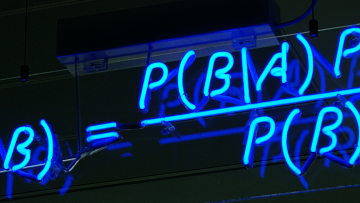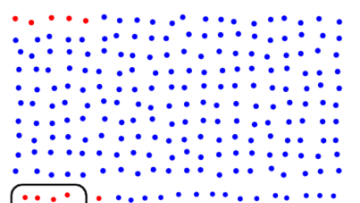Humans love to find an explanation that fits the facts, and fits them as closely as possible. But this often turns out to be a terrible way of learning about the world around us.
In the latest instalment of the Oxford Mathematics Alphabet we look at Bayes’ Theorem and how it is used in criminology, product recommendations, artificial intelligence, and recently in the search for the missing Malaysian Airliner MH370.
Strongly semistable sheaves and the Mordell-Lang conjecture over function fields
Abstract
We shall describe a new proof of the Mordell-Lang conjecture in positive characteristic, in the situation where the variety under scrutiny is a smooth subvariety of an abelian variety.
Our proof is based on the theory of semistable sheaves in positive characteristic, in particular on Langer's theorem that the Harder-Narasimhan filtration of sheaves becomes strongly semistable after a finite number of iterations of Frobenius pull-backs. Our proof produces a numerical upper-bound for the degree of the finite morphism from an isotrivial variety appearing in the statement of the Mordell-Lang conjecture. This upper-bound is given in terms of the Frobenius-stabilised slopes of the cotangent bundle of the variety.
(Joint Number Theory and Logic) On a modular Fermat equation
Abstract
I will describe some diophantine problems and results motivated by the analogy between powers of the modular curve and powers of the multiplicative group in the context of the Zilber-Pink conjecture.
Modelling, analysis, and (some) numerics for cardiac electromechanics
On multigrid methods in convex optimization
Abstract
The aim of this talk is to design an efficient multigrid method for constrained convex optimization problems arising from discretization of some underlying infinite dimensional problems. Due to problem dependency of this approach, we only consider bound constraints with (possibly) a linear equality constraint. As our aim is to target large-scale problems, we want to avoid computation of second
derivatives of the objective function, thus excluding Newton like methods. We propose a smoothing operator that only uses first-order information and study the computational efficiency of the resulting method. In the second part, we consider application of multigrid techniques to more general optimization problems, in particular, the topology design problem.
Tensor product approach for solution of multidimensional differential equations
Abstract
Partial differential equations with more than three coordinates arise naturally if the model features certain kinds of stochasticity. Typical examples are the Schroedinger, Fokker-Planck and Master equations in quantum mechanics or cell biology, as well as quantification of uncertainty.
The principal difficulty of a straightforward numerical solution of such equations is the `curse of dimensionality': the storage cost of the discrete solution grows exponentially with the number of coordinates (dimensions).
One way to reduce the complexity is the low-rank separation of variables. One can see all discrete data (such as the solution) as multi-index arrays, or tensors. These large tensors are never stored directly.
We approximate them by a sum of products of smaller factors, each carrying only one of the original variables. I will present one of the simplest but powerful of such representations, the Tensor Train (TT) decomposition. The TT decomposition generalizes the approximation of a given matrix by a low-rank matrix to the tensor case. It was found that many interesting models allow such approximations with a significant reduction of storage demands.
A workhorse approach to computations with the TT and other tensor product decompositions is the alternating optimization of factors. The simple realization is however prone to convergence issues.
I will show some of the recent improvements that are indispensable for really many dimensions, or solution of linear systems with non-symmetric or indefinite matrices.
Redundant function approximation in theory and in practice
Abstract
Functions are usually approximated numerically in a basis, a non-redundant and complete set of functions that span a certain space. In this talk we highlight a number of benefits of using overcomplete sets, in particular using the more general notion of a "frame". The main benefit is that frames are easily constructed even for functions of several variables on domains with irregular shapes. On the other hand, allowing for possible linear depencies naturally leads to ill-conditioning of approximation algorithms. The ill-conditioning is potentially severe. We give some useful examples of frames and we first address the numerical stability of best approximations in a frame. Next, we briefly describe special point sets in which interpolation turns out to be stable. Finally, we review so-called Fourier extensions and an efficient algorithm to approximate functions with spectral accuracy on domains without structure.
Customising image analysis using nonlinear partial differential equations
Abstract
When assigned with the task of extracting information from given image data the first challenge one faces is the derivation of a truthful model for both the information and the data. Such a model can be determined by the a-priori knowledge about the image (information), the data and their relation to each other. The source of this knowledge is either our understanding of the type of images we want to reconstruct and of the physics behind the acquisition of the data or we can thrive to learn parametric models from the data itself. The common question arises: how can we customise our model choice to a particular application? Or better how can we make our model adaptive to the given data?
Starting from the first modelling strategy this talk will lead us from nonlinear diffusion equations and subdifferential inclusions of total variation type functionals as the most successful image modeltoday to non-smooth second- and third-order variational models, with data models for Gaussian and Poisson distributed data as well as impulse noise. These models exhibit solution-dependent adaptivities in form of nonlinearities or non-smooth terms in the PDE or the variational problem, respectively. Applications for image denoising, inpainting and surface reconstruction are given. After a critical discussion of these different image and data models we will turn towards the second modelling strategy and propose to combine it with the first one using a PDE constrained optimisation method that customises a parametrised form of the model by learning from examples. In particular, we will consider optimal parameter derivation for total variation denoising with multiple noise distributions and optimising total generalised variation regularisation for its application in photography.



